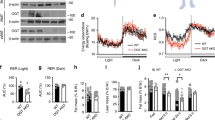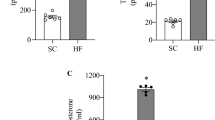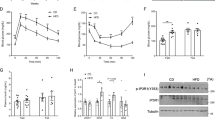Abstract
Obesity is associated with increased storage of lipids in nonadipose tissues like skeletal muscle, liver, and pancreatic β cells. These lipids constitute a continuous source of long-chain fatty acyl CoA (LC-CoA) and derived metabolites like diacylglycerol and ceramide, acting as signalling molecules on protein kinases activities (in particular, the family of PKCs), ion channel, gene expression, and protein acylation. In skeletal muscle, the increase in LC-CoA and diacylglycerol translocates and activates specific protein kinase C (PKC) isoforms, which will phosphorylate IRS-1 on serine, preventing its phosphorylation on tyrosine and association with PI3 kinase. This interrupts the insulin signalling pathway leading to the stimulation of glucose transport. In pancreatic β cells, short-term excess of fatty acids or LC-CoA activates PKC and also directly stimulates insulin exocytosis. Long-term exposure to free fatty acids (FFA) leads to an increased basal and blunted glucose-stimulated insulin secretion by affecting gene expression, increase in KATP channel activity, and uncoupling of the mitochondria. In addition, the saturated FFA palmitate increases cell death by apoptosis via increase in ceramide synthesis.
This is a preview of subscription content, access via your institution
Access options
Subscribe to this journal
Receive 12 print issues and online access
$259.00 per year
only $21.58 per issue
Buy this article
- Purchase on Springer Link
- Instant access to full article PDF
Prices may be subject to local taxes which are calculated during checkout

Similar content being viewed by others
References
McGarry JD . What if Minkowski had been ageusic? An alternative angle on diabetes. Science 1992; 258: 766–770.
Boden G, Carnell LH . Nutritional effects of fat on carbohydrate metabolism. Best Pract Res Clin Endocrinol Metab 2003; 17: 399–410.
Malaisse WJ, Best L, Kawazu S, Malaisse-Lagae F, Sener A . The stimulus-secretion coupling of glucose-induced insulin release: fuel metabolism in islets deprived of exogenous nutrient. Arch Biochem Biophys 1983; 224: 102–110.
Balasse EO, Ooms HA . Role of plasma free fatty acids in the control of insulin secretion in man. Diabetologia 1973; 9: 145–151.
Dobbins RL, Chester MW, Daniels MB, McGarry JD, Stein DT . Circulating fatty acids are essential for efficient glucose-stimulated insulin secretion after prolonged fasting in humans. Diabetes 1998; 47: 1613–1618.
Crespin SR, Greenough III WB, Steinberg D . Stimulation of insulin secretion by infusion of free fatty acids. J Clin Invest 1969; 48: 1934–1943.
Paolisso G, Gambardella A, Amato L, Tortoriello R, D'Amore A, Varricchio M, D'Onofrio F . Opposite effects of short- and long-term fatty acid infusion on insulin secretion in healthy subjects. Diabetologia 1995; 38: 1295–1299.
Stein DT, Stevenson BE, Chester MW, Basit M, Daniels MB, Turley SD, McGarry JD . The insulinotropic potency of fatty acids is influenced profoundly by their chain length and degree of saturation. J Clin Invest 1997; 100: 398–403.
Prentki M, Tornheim K, Corkey BE . Signal transduction mechanisms in nutrient-induced insulin secretion. Diabetologia 1997; 40 (Suppl 2): S32–S41.
Yaney GC, Korchak HM, Corkey BE . Long-chain acyl CoA regulation of protein kinase C and fatty acid potentiation of glucose-stimulated insulin secretion in clonal beta-cells. Endocrinology 2000; 141: 1989–1998.
Dobbins RL, Chester MW, Stevenson BE, Daniels MB, Stein DT, McGarry JD . A fatty acid-dependent step is critically important for both glucose- and non-glucose-stimulated insulin secretion. J Clin Invest 1998; 101: 2370–2376.
Prentki M, Vischer S, Glennon MC, Regazzi R, Deeney JT, Corkey BE . Malonyl-CoA and long chain acyl-CoA esters as metabolic coupling factors in nutrient-induced insulin secretion. J Biol Chem 1992; 267: 5802–5810.
Itoh Y, Kawamata Y, Harada M, Kobayashi M, Fujii R, Fukusumi S, Ogi K, Hosoya M, Tanaka Y, Uejima H, Tanaka H, Maruyama M, Satoh R, Okubo S, Kizawa H, Komatsu H, Matsumura F, Noguchi Y, Shinohara T, Hinuma S, Fujisawa Y, Fujino M . Free fatty acids regulate insulin secretion from pancreatic beta cells through GPR40. Nature 2003; 422: 173–176.
Butler AE, Janson J, Bonner-Weir S, Ritzel R, Rizza RA, Butler PC . Beta-cell deficit and increased beta-cell apoptosis in humans with type 2 diabetes. Diabetes 2003; 52: 102–110.
Hosokawa H, Corkey BE, Leahy JL . Beta-cell hypersensitivity to glucose following 24-h exposure of rat islets to fatty acids. Diabetologia 1997; 40: 392–397.
Brun T, Assimacopoulos-Jeannet F, Corkey BE, Prentki M . Long-chain fatty acids inhibit acetyl-CoA carboxylase gene expression in the pancreatic beta-cell line INS-1. Diabetes 1997; 46: 393–400.
Lameloise N, Muzzin P, Prentki M, Assimacopoulos-Jeannet F . Uncoupling protein 2: a possible link between fatty acid excess and impaired glucose-induced insulin secretion? Diabetes 2001; 50: 803–809.
Ritz-Laser B, Meda P, Constant I, Klages N, Charollais A, Morales A, Magnan C, Ktorza A, Philippe J . Glucose-induced preproinsulin gene expression is inhibited by the free fatty acid palmitate. Endocrinology 1999; 140: 4005–4014.
Branstrom R, Leibiger IB, Leibiger B, Corkey BE, Berggren PO, Larsson O . Long chain coenzyme A esters activate the pore-forming subunit (Kir6. 2) of the ATP-regulated potassium channel. J Biol Chem 1998; 273: 31395–31400.
Segall L, Lameloise N, Assimacopoulos-Jeannet F, Roche E, Corkey P, Thumelin S, Corkey BE, Prentki M . Lipid rather than glucose metabolism is implicated in altered insulin secretion caused by oleate in INS-1 cells. Am J Physiol 1999; 277: E521–E528.
Dobbins RL, Szczepaniak LS, Myhill J, Tamura Y, Uchino H, Giacca A, McGarry JD . The composition of dietary fat directly influences glucose-stimulated insulin secretion in rats. Diabetes 2002; 51: 1825–1833.
Mulder H, Holst LS, Svensson H, Degerman E, Sundler F, Ahren B, Rorsman P, Holm C . Hormone-sensitive lipase, the rate-limiting enzyme in triglyceride hydrolysis, is expressed and active in beta-cells. Diabetes 1999; 48: 228–232.
Liang Y, Buettger C, Berner DK, Matschinsky FM . Chronic effect of fatty acids on insulin release is not through the alteration of glucose metabolism in a pancreatic beta-cell line (beta HC9). Diabetologia 1997; 40: 1018–1027.
Maedler K, Oberholzer J, Bucher P, Spinas GA, Donath MY . Monounsaturated fatty acids prevent the deleterious effects of palmitate and high glucose on human pancreatic beta-cell turnover and function. Diabetes 2003; 52: 726–733.
El-Assaad W, Buteau J, Peyot ML, Nolan C, Roduit R, Hardy S, Joly E, Dbaibo G, Rosenberg L, Prentki M . Saturated fatty acids synergize with elevated glucose to cause pancreatic beta-cell death. Endocrinology 2003; 144: 4154–4163.
Randle PJ, Kerbey AL, Espinal J . Mechanisms decreasing glucose oxidation in diabetes and starvation: role of lipid fuels and hormones. Diabetes Metab Rev 1988; 4: 623–638.
Shulman GI . Cellular mechanisms of insulin resistance. J Clin Invest 2000; 106: 171–176.
Kelley DE, Goodpaster BH, Storlien L . Muscle triglyceride and insulin resistance. Annu Rev Nutr 2002; 22: 325–346.
Kim JK, Fillmore JJ, Chen Y, Yu C, Moore IK, Pypaert M, Lutz EP, Kako Y, Velez-Carrasco W, Goldberg IJ, Breslow JL, Shulman GI . Tissue-specific overexpression of lipoprotein lipase causes tissue-specific insulin resistance. Proc Natl Acad Sci USA 2001; 98: 7522–7527.
Oakes ND, Bell KS, Furler SM, Camilleri S, Saha AK, Ruderman NB, Chisholm DJ, Kraegen EW . Diet-induced muscle insulin resistance in rats is ameliorated by acute dietary lipid withdrawal or a single bout of exercise: parallel relationship between insulin stimulation of glucose uptake and suppression of long-chain fatty acyl-CoA. Diabetes 1997; 46: 2022–2028.
Dobbins RL, Szczepaniak LS, Bentley B, Esser V, Myhill J, McGarry JD . Prolonged inhibition of muscle carnitine palmitoyltransferase-1 promotes intramyocellular lipid accumulation and insulin resistance in rats. Diabetes 2001; 50: 123–130.
Hajri T, Han XX, Bonen A, Abumrad NA . Defective fatty acid uptake modulates insulin responsiveness and metabolic responses to diet in CD36-null mice. J Clin Invest 2002; 109: 1381–1389.
Oakes ND, Kennedy CJ, Jenkins AB, Laybutt DR, Chisholm DJ, Kraegen EW . A new antidiabetic agent, BRL 49653, reduces lipid availability and improves insulin action and glucoregulation in the rat. Diabetes 1994; 43: 1203–1210.
Hegarty BD, Cooney GJ, Kraegen EW, Furler SM . Increased efficiency of fatty acid uptake contributes to lipid accumulation in skeletal muscle of high fat-fed insulin-resistant rats. Diabetes 2002; 51: 1477–1484.
Kelley DE, He J, Menshikova EV, Ritov VB . Dysfunction of mitochondria in human skeletal muscle in type 2 diabetes. Diabetes 2002; 51: 2944–2950.
Petersen KF, Dufour S, Befroy D, Garcia R, Shulman GI . Impaired mitochondrial activity in the insulin-resistant offspring of patients with type 2 diabetes. N Engl J Med 2004; 350: 664–671.
Griffin ME, Marcucci MJ, Cline GW, Bell K, Barucci N, Lee D, Goodyear LJ, Kraegen EW, White MF, Shulman GI . Free fatty acid-induced insulin resistance is associated with activation of protein kinase C theta and alterations in the insulin signaling cascade. Diabetes 1999; 48: 1270–1274.
Yu C, Chen Y, Cline GW, Zhang D, Zong H, Wang Y, Bergeron R, Kim JK, Cushman SW, Cooney GJ, Atcheson B, White MF, Kraegen EW, Shulman GI . Mechanism by which fatty acids inhibit insulin activation of insulin receptor substrate-1 (IRS-1)-associated phosphatidylinositol 3-kinase activity in muscle. J Biol Chem 2002; 277: 50230–50236.
Tanti JF, Gremeaux T, van Obberghen E, Le Marchand-Brustel Y . Serine/threonine phosphorylation of insulin receptor substrate 1 modulates insulin receptor signaling. J Biol Chem 1994; 269: 6051–6057.
Itani SI, Ruderman NB, Schmieder F, Boden G . Lipid-induced insulin resistance in human muscle is associated with changes in diacylglycerol, protein kinase C, and IkappaB-alpha. Diabetes 2002; 51: 2005–2011.
Thompson AL, Cooney GJ . Acyl-CoA inhibition of hexokinase in rat and human skeletal muscle is a potential mechanism of lipid-induced insulin resistance. Diabetes 2000; 49: 1761–1765.
Author information
Authors and Affiliations
Corresponding author
Rights and permissions
About this article
Cite this article
Assimacopoulos-Jeannet, F. Fat storage in pancreas and in insulin-sensitive tissues in pathogenesis of type 2 diabetes. Int J Obes 28 (Suppl 4), S53–S57 (2004). https://doi.org/10.1038/sj.ijo.0802857
Published:
Issue Date:
DOI: https://doi.org/10.1038/sj.ijo.0802857



